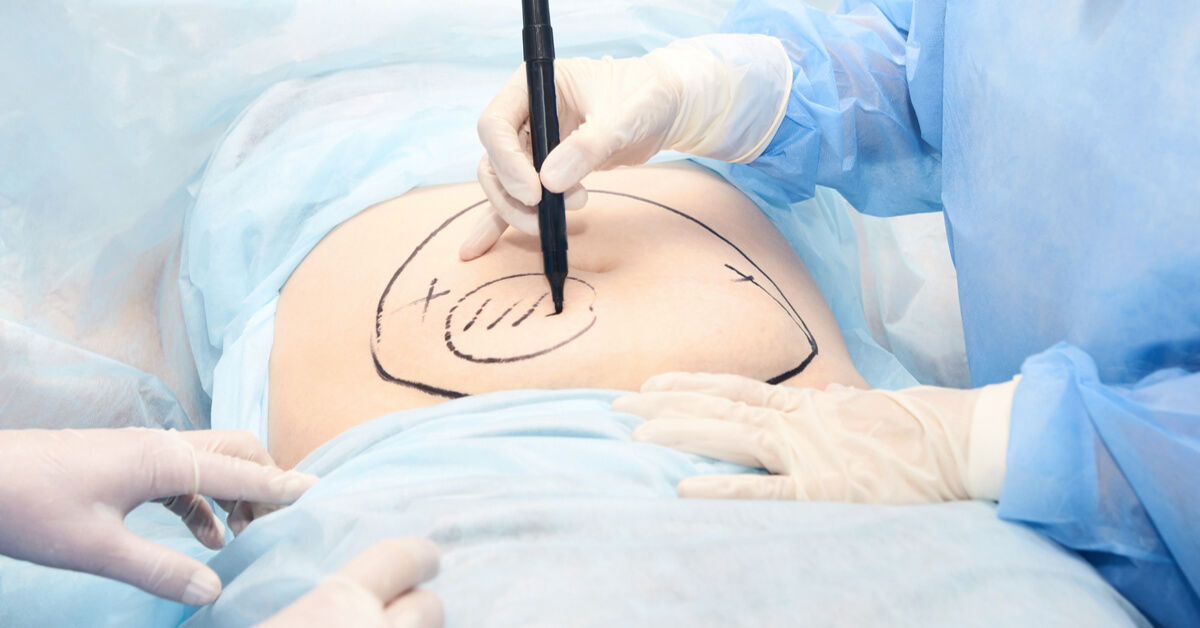The common problems of 7 out of 10 women after giving birth are loose lower abdominal muscle and sagging belly. It may take time for the body to recover and return to its pre-pregnancy state. Depending on factors such as pregnancy weight, the baby’s being overweight, the increase in the number of births, caesarean delivery (C-section) and genetic structure, the period of recovery of the abdomen may vary. In some women, the underlying reasons for not flattening the abdomen may be different. Diastasis recti (separation of the rectus abdominis) is one of these reasons. Although it affects approximately 70% of women giving birth, it is not well known by many. What are the symptoms of it? How is it understood? How can it be treated?
Here are some of the most common questions along with the best way to answer them.
What Is Diastasis Recti?
Diastasis recti is a health problem that is not known as a name, but that many people have unawares. The word diastasis means “separation” and recti means “rectus abdominis”, that is, abdominal muscles (upright abdominal muscles).
The muscles that surround both the anterior and lateral parts of the abdomen, descending from the middle of the body, form the structure called the linea alba. This structure is stretched by being subjected to pressure for various reasons and stretches and separates by opening from the middle to both sides. As a result, the muscles relax. Since the structure surrounding the organs and fat layer in the inner abdomen is deformed, these organs form a bulge outward and create a navel image. This situation is called diastasis recti -separation of the rectus abdominis-.
What Causes Diastasis Recti?
In general, there is no single cause. The combination of possible causes and the increase in the internal pressure of the abdomen result in diastasis recti.
The causes of separation of the rectus abdominis are as follows.
- Excessive pressure on the abdominal muscles of the growing uterus during pregnancy
- Pregnancy weights
- Relaxing the ligaments surrounding the abdominal muscles dur to pregnancy hormones
- Wrong exercise movements
- Lifting and carrying too much weight in the wrong position
- Body anatomy
- Not using the correct position when lying down and getting up
- Standing by pushing the ribs forward to stand upright
What Are the Symptoms of Diastasis Recti?
It is normal for every woman to have a certain amount of separating in the abdominal muscles. With the expansion of the uterus and the stretching of the muscles, the upright abdominal muscles split into two, creating a separation. If this separation is at an advanced level, it may be inevitable that some complaints will arise.
The presence of the following complaints and findings may raise the suspicion of diastasis.
- If there is tightening in the upper abdomen, but the lower abdomen does not tighten
- If the belly protrudes after meals
- If belly bloating persists despite returning to pre-pregnancy weight
- If there is excessive swelling in the abdomen
- If you have back and waist pain
- If you have urinary incontinence or incontinence when sneezing
- If you have constipation
- If you have bad posture
These symptoms may indicate diastasis recti. Diastasis recti is a problem that can occur not only in women, but also in men and new-born babies. Therefore, if you are observing some of these symptoms and cannot make sense of the swelling in your abdomen, you may have diastasis. You should visit a doctor.
How Is Diastasis Recti Diagnosed?
Once the symptoms of diastasis recti are noticed, it can be difficult to decide whether the problem is diastasis or navel. It is better for a specialist to make the diagnosis, but you can also find out at home whether there is diastasis recti or not.
It is possible to diagnose it with a simple finger test:
- Lie on your back on a flat surface.
- Position yourself with feet on the floor and knees bent.
- Place 2-3 fingers of one hand on your belly button with the palm of your hand facing your stomach.
- With your other hand, support your head and neck and straighten slightly, as if doing a sit-up.
- If you feel like your fingers are running through a gap or sinking deeply, you may be talking about an opening between the muscles.
- If you feel tension in the muscles under the fingers, it may be just the navel.
- Apply the same movement 4 cm below and 4 cm above the navel and try to identify the points where the opening begins and ends.
As a result of the test;
- If the separation is 5 cm long and 1 cm wide, it is small diastasis,
- If the separation is 10 cm long and 2 cm wide, it is mild diastasis,
- If the separation is longer than 10 cm and wider than 2 cm, it is severe diastasis.
While diastases other than small diastases are quite difficult to heal spontaneously and completely, small diastases may close on their own after a while. In mild diastasis, you can strengthen your muscles with daily exercise movements.
Who Is Diastasis Recti More Common in?
Considering that the problem of diastasis recti is a very common problem, it is possible to mention some risk factors.
The following people are most likely to develop diastasis recti:
- In women with a high number of pregnancies and births
- In mothers giving birth to babies with high birth weight
- In women who have had multiple pregnancies (twins, triplets)
- In women who have gained excessive weight during pregnancy
- In those with a high body mass index and at risk of obesity (Abdominal fat puts high pressure on the abdominal muscles and the risk increases.)
- In those with a genetic predisposition
- In elderly individuals (Aging is a factor that weakens the muscles.)
- In those who experience frequent and sudden changes in body weight (constant weight gain and loss)
- In those who apply pressure to their abdominal muscles regularly (The risk increases in those who do heavy exercises.)
- In new-borns and premature babies whose abdominal muscles have not yet developed

How Is Diastasis Recti Treated?
It affects the appearance of the abdomen and the body, and often negatively affects the quality of life of the person. How to treat diastasis recti is a matter of curiosity, especially for new mothers.
Different treatment methods can be applied according to the severity of relaxation and separation in the muscles. If the separation in the abdominal muscles is slight, the abdomen can be restored after a certain time by stimulating the ligaments in the abdominal region. With light exercise movements applied after birth, the separation can be closed over time. On the other hand, the healing process may take longer depending on the severity of the problem and most of the time diastasis recti does not close on its own. Many factors such as age, abdominal fat and muscle strength are effective in the development of this condition. In such cases, one or more of the following options are taken into consideration.
- Movements that strengthen the back, hips and abdomen
- Physiotherapy applications
- Surgical operation (Abdominal stretching surgeries)
Among these applications, you should decide which method is most suitable for your situation by consulting your doctor. Otherwise, unconscious compulsive and adverse movements may cause the problem to progress or recur.
Surgical Treatment in Diastasis Recti
Diastasis recti cases that do not go away on their own, affect daily life and create a cosmetically bad appearance can be treated surgically.
Different methods can be applied in surgical treatments:
- Traditional technique: This method is performed by making a surgical incision in the patient’s problem area. It is known as classical tummy tuck surgery. In addition to the elimination of the problem, the excess fat, skin and tissue layer are removed from the area and the procedure is completed. Recovery time is longer compared to other methods.
- Laparoscopic technique: It is a surgical procedure performed with the use of light, camera and various medical instruments. The treatment is performed with the help of a tube placed in a small incision in the area. The patient recovers faster than the traditional technique.
- Endoscopic technique: In this technique, no incision is made on the abdomen. The treatment is carried out by reaching the abdomen with the help of light, camera and surgical instruments from the patient’s throat to the oesophagus. The patient recovers faster than the traditional technique.
After the diastasis recti is treated surgically, there is a risk of some complications.
- Post-operative pain
- Risk of tearing, opening and infection in the wound area
- Risk of rupture of blood vessels in the area
- Minor skin losses
- Nerve damage
Appropriate Exercises for Abdominal Muscle Separation
Exercise Practice in Diastasis Recti
Exercise is used as a very effective method in the treatment of diastasis recti. When the right movements are performed regularly, the connective tissue is stimulated to regain its former strength and the separation in the muscles gradually closes. On the other hand, there are no studies showing that exercise can be a definitive solution for advanced severe cases. However, with appropriate movements, the progression and worsening of the separation in the vertical muscles on both sides of the body can be prevented. Posture disorders can be corrected, complaints such as pain and swelling can be reduced. In short, it is known that diastasis recti exercises support recovery by reducing the pressure on the muscles.
There are some exercise movements to strengthen the linea alba structure. Based on these movements, it is essential to increase the core, that is, the inner strength. While it is aimed to regain strength of the muscles that have loosened and lost their former strength, the pressure on the abdominal wall is tried to be reduced.
- Abdominal vacuum: This movement, which targets the deepest muscle of the abdomen known as the transverse abdomen, can be done in 3 different ways by pulling the abdomen in like a vacuum.
Method 1: Stand up and place your hands on your lower back for support. Take a deep breath, as you exhale forcefully through your mouth, pull in your stomach as much as you can. Stay as long as you can with your muscles contracted. Then count to 3 and repeat the movement.
Method 2: Stand on your knees and hands on the floor. Position yourself so that the knees are in line with the hips and the hands are in line with the shoulders. While doing the breathing movement, pull in your stomach and repeat the movement.
Method 3: Lie on the floor in a supine position and bend your knees so that your feet are on the floor. While doing the breathing movement, pull in your stomach and repeat the movement.
- Russian twist: Sit on the floor with your body slightly bent backwards. Get a ball that you can grasp with both palms. Keep your feet in the air with your feet together and knees bent. Keep your balance and move the ball by turning first to the right and then to the left.
- Glute bridge: Lie on the floor in a supine position. Bend your knees and bring your feet closer to the hips to a comfortable level with weight on your heels. Place your arms on either side of you. Support your heels as you breathe in and push your hips up as you breathe out in a controlled way. Repeat the movement when you feel your glutes tense.
- Bird dog: Position yourself on the ground on your hands and knees. Stand with hands in line with shoulders and knees in line with hips. While raising your right leg high enough to be in line with your back, simultaneously lift your left arm forward and maintain your balance. Then pull your knee and elbow in until they touch each other and repeat the movement 15 times. Do the same movement in the opposite direction, that is, for the left leg and right arm.
- Tabletop: Lie on the floor with your waist and back completely flat on the floor. Extend your arms to your sides. Bend your knees slightly. With the soles of your feet flat on the ground, alternately lift and lower your feet in line with your hips.
- Superman move: Lie on the floor in a prone position. Take a position with your arms extended forward. Repeat the movement alternately by simultaneously raising one arm and leg in the diagonal direction. Make sure that the back and abdominal muscles are tense during the application.
It is necessary to avoid movements that will exert pressure by pushing the abdominal wall outward while exercising in abdominal muscle separations. These movements may trigger diastasis. Mothers who have given birth can start exercises as soon as their condition allows, with the approval of the doctor.
Would you like to share your experiences and questions as a comment?
Have a nice and healthy day!







